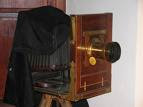History OF CAMERA
Mar 28, 2010
History OF CAMERA
The technology that the modern camera is based on was created several hundred years ago. Although the ancient ideas were far away from the types of cameras that we know, they were well ahead of their time in relation to the technology and materials that they had at their disposal. It wasn’t until 1885 when George Eastman created the modern photograph film technology that made cameras a convenient product for consumers. Eastman also created the very first Kodak camera which served to further advance the camera industry and its popularity among consumers.
The first Kodak camera was sold with the film already loaded inside and consumers needed to send the entire unit to the company to get their film developed. The company would then reload the camera with new film and send it back to the consumer so they could take more pictures with it. But this system did not last very long before more advancements were made.
In the first year of the 20th century, 1901 George Eastman capitalized on his own technology and created the Brownie. This new camera was the first one that had the capability of taking snapshots and it was small enough to be convenient for camera owners to carry around with them. As a result of its popularity, affordability and small size, the Brownie was the preferred camera that families could take with them on vacations and special occasions to create memories that would last a lifetime. The Brownie was so popular that it continued to be produced and marketed well into the 1960s.
In 1914, Oskar Barnack experimented with 35mm film that was used to create movies and films. His goal was to create a 35mm film that could be used in cameras to create still pictures rather than motion pictures. Though he began this technology in 1914, the troubles that occurred with the onset of World War I made further advancements impossible for the next several years. Twenty years later, the Kodak Company began working on this technology and made several advancements that made it more convenient for average consumers to use. The Retina I by the Kodak Company was cheaper than other models with similar technology, but it was still more expensive than other mass produced cameras of the era.
While many companies were trying to create better technology for their cameras, a new type of camera jetted onto the scene in 1948. The Polaroid was an instant camera that attracted many consumers because of its instant gratification capabilities. People could take a picture with the Polaroid camera and have their photo in a matter of minutes. Even though it was more expensive than the other cameras of the time, it was still one of the biggest selling models because people enjoyed having their pictures just moments after taking them. It was a novelty at first, but it soon became a luxury that many people had to have. Even today, the Polaroid camera is one of the best selling models in the camera industry because of its affordable price and instant capabilities.
In recent years, the digital technology even spilled over into the camera industry. Even though the predecessors of today’s digital cameras began in 1972 with a Texas Instruments prototype, the true digital camera as we know them today was not produced until 1988 in Japan and later in 1991 in the United States
Cameras have helped to reshape our history because we can actually see photographs of things that have happened. We can get a better idea of events through still pictures and videos, too. The adage “A picture is worth a thousand words” is not very far off from the way that cameras have helped to revolutionize the way we see our world and our surroundings.














0 comments:
Post a Comment